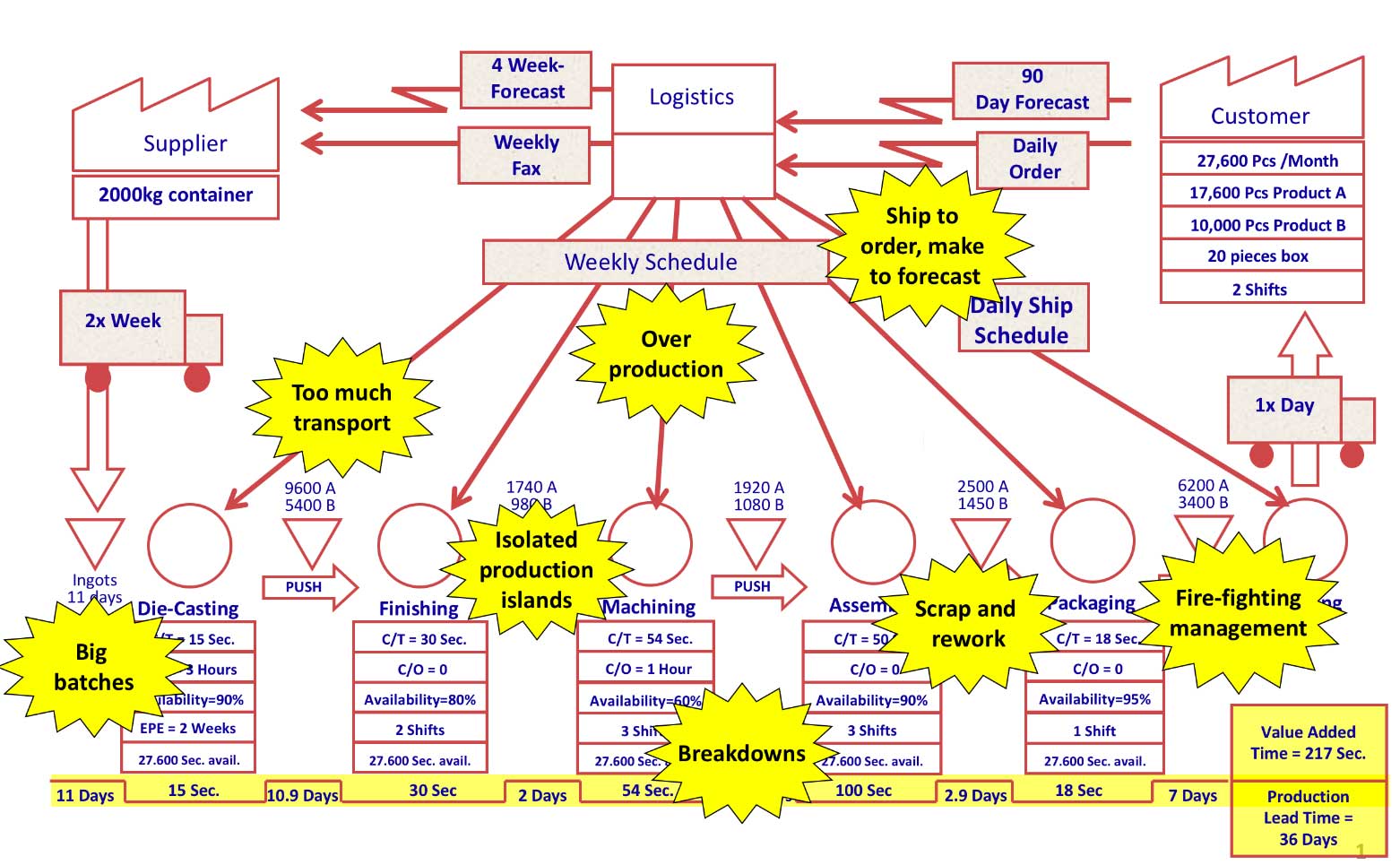What is value stream mapping?
Value stream mapping is a flowchart method to illustrate, analyze and improve the steps required to deliver a product or service. A key part of lean methodology, VSM reviews the flow of process steps and information from origin to delivery to the customer. As with other types of flowcharts, it uses a system of symbols to depict various work activities and information flows. VSM is especially useful to find and eliminate waste. Items are mapped as adding value or not adding value from the customer’s standpoint, with the purpose of rooting out items that don’t add value.
It’s important to keep in mind that customers, whether external or internal, care about the value of the product or service to them, not the efforts it took to produce it, or the value that may flow to other customers. Value stream mapping maintains that focus. A typical process is to draw a current state VSM and then model a better way with a future state and/or ideal state VSM. You can start off sketching by hand and then move to VSM software for better communication, analysis and collaboration.
VSM purpose and benefits

Value stream mapping is a powerful method to ferret out waste in any process, not just manufacturing. That’s its core purpose. You detail each significant process step and evaluate how it’s adding value—or not adding value—from the customer’s standpoint. That focus on value keeps the analysis targeted to what really matters, allowing the company to compete most effectively in the market. Foreseeing or facing any competitive threat, lean practitioners can make good use of VSM to produce the most value for the customer in the most efficient way possible. It can and should be used on an ongoing basis for continuous improvement, bringing better and better process steps on line. VSM allows you to see not only the waste, but the source or cause of the waste.
Value stream mapping, as with other good visualizations, serves as an effective tool for communication, collaboration and even culture change. Decision makers can clearly visualize the current state of the process and where waste is occurring. They can see problems like process delays, excessive downtime, constraints and inventory issues. And with the Future State and/or Ideal State VSM, they can see precisely how to improve.
Although its typical purpose is eliminating waste, VSM can also be seen from the perspective of adding value. After all, that’s what the customer cares about. Eliminating waste is the means to an end of creating value, such as a lower price and/or better-quality product or service. Value is something a customer is willing to pay for. The title of a popular VSM book is even: Learning to See: Value Stream Mapping to Add Value and Eliminate Muda, by Mike Rother and John Shook. (Muda is lean terminology for waste.)
VSM caveats
While Value Stream Mapping is core to lean methods, it often requires a substantial investment of people and time to do it, and if not applied wisely, it can be wasteful in itself. You of course want profitable applications of value stream mapping.
It requires team members skilled in carrying out advanced VSM, and it may take days, weeks or even months to carry out some involved mapping projects. Think of it as a powerful tool central to lean methods, but not every circumstance lends itself to value stream mapping. You need to balance potential value with the work necessary to conduct the VSM.
You might choose to start small, with a limited focus and a limited budget, get the win and then move on to something more complex and potentially rewarding. Oftentimes, senior leaders may try to bite off something too large initially, and the effort may struggle due to its complexity and possible inexperience of the team.
Potential uses of more extensive VSM include:
• Cases involving multiple functional areas or departments.
• When a less detailed process map isn’t likely to uncover information you can act on.
• To make the case for a large investment that will result in much larger savings.
Remember, an improvement in one process step or in one part of production won’t always translate to a bottom line improvement. Often, a fuller look will be required.
However, keeping those caveats in mind, an individual could try VSM on a budget for a simple review that might produce results or at least help you to better understand VSM. After reading up on the basics (and you’re off to a good start with this article), you might just grab a pencil and legal-size pad, and armed with the step-by-step instructions listed later in this article, start mapping. You’ll map out the process steps, data for each step (such as cycle time), improvements you think you could make for an “ideal state,” and a summary showing how your improvements help each data point and overall value. Just keep in mind that this would be a tiny taste of what expert value stream mapping can accomplish.
If
you would like more information, training, project support and supply chain
management please contact us. Email: bensing.yang@sinuoph.com